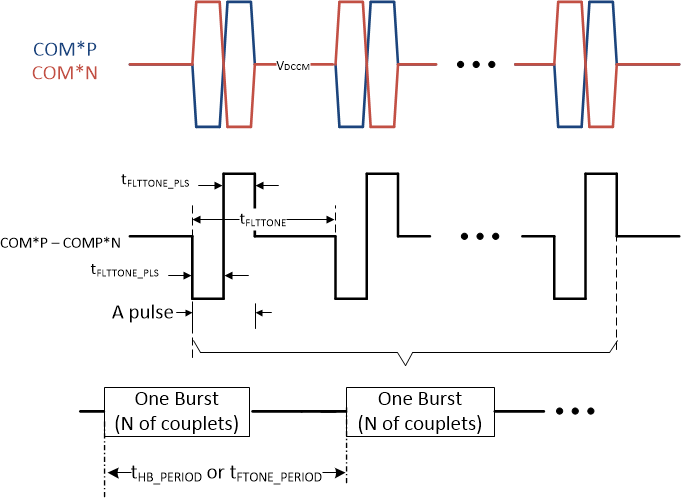ZHCSR35A November 2019 – August 2020 BQ79600-Q1
PRODUCTION DATA
- 1 特性
- 2 应用
- 3 说明
- 4 Revision History
- 5 Pin Configuration and Functions
- 6 规格
-
7 Detailed Description
- 7.1 Overview
- 7.2 Functional Block Diagram
- 7.3
Feature Description
- 7.3.1 Functional Modes and Power Supply
- 7.3.2 Communication
- 7.3.3 Fault Handling
- 7.3.4 INH/ Reverse Wakeup
- 7.3.5 Sniff Detector
- 7.3.6 Device Diagnostic
- 7.4 Device Functional Modes
- 7.5
Register Maps
- 7.5.1 Register Summary Table
- 7.5.2 Register: DIR0_ADDR
- 7.5.3 Register: DIR1_ADDR
- 7.5.4 Register: CONTROL1
- 7.5.5 Register: CONTROL2
- 7.5.6 Register: DIAG_CTRL
- 7.5.7 Register: DEV_CONF1
- 7.5.8 Register: DEV_CONF2
- 7.5.9 Register: TX_HOLD_OFF
- 7.5.10 Register: SLP_TIMEOUT
- 7.5.11 Register: COMM_TIMEOUT
- 7.5.12 Register: SPI_FIFO_UNLOCK
- 7.5.13 Register: FAULT_MSK
- 7.5.14 Register: FAULT_RST
- 7.5.15 Register: FAULT_SUMMARY
- 7.5.16 Register: FAULT_REG
- 7.5.17 Register: FAULT_SYS
- 7.5.18 Register: FAULT_PWR
- 7.5.19 Register: FAULT_COMM1
- 7.5.20 Register: FAULT_COMM2
- 7.5.21 Register: DEV_DIAG_STAT
- 7.5.22 Register: PARTID
- 7.5.23 Register: DIE_ID1
- 7.5.24 Register: DIE_ID2
- 7.5.25 Register: DIE_ID3
- 7.5.26 Register: DIE_ID4
- 7.5.27 Register: DIE_ID5
- 7.5.28 Register: DIE_ID6
- 7.5.29 Register: DIE_ID7
- 7.5.30 Register: DIE_ID8
- 7.5.31 Register: DIE_ID9
- 7.5.32 Register: DEBUG_CTRL_UNLOCK
- 7.5.33 Register: DEBUG_COMM_CTRL
- 7.5.34 Register: DEBUG_COMM_STAT
- 7.5.35 Register: DEBUG_SPI_PHY
- 7.5.36 Register: DEBUG_SPI_FRAME
- 7.5.37 Register: DEBUG_UART_FRAME
- 7.5.38 Register: DEBUG_COMH_PHY
- 7.5.39 Register: DEBUG_COMH_FRAME
- 7.5.40 Register: DEBUG_COML_PHY
- 7.5.41 Register: DEBUG_COML_FRAME
- 8 Application and Implementation
- 9 Power Supply Recommendations
- 10Layout
- 11Device and Documentation Support
- 12Mechanical, Packaging, and Orderable Information
7.3.2.2 Tone Communication Protocol
Other than data, certain information is transmitted using tone: signals to change power state of stack device (SLP2ACT tone, WAKE tone, SHUTDOWN tone, HWRST tone), signals related to faults (FAULT tone and HEARTBEAT tone). The definition of each tone is defined in Figure 7-22 and Figure 7-21.
Device can transmit and receive tones in summary below:
Table 7-7 Available Tones to BQ79600-Q1
| DIRECTION | NAME |
|---|---|
| Receive | FAULT tone and HEARTBEAT tone |
| Transmit | SLP2ACT tone, WAKE tone, SHUTDOWN tone, HWRST tone, HEARTBEAT tone |
Note:
- Device does not transmit Fault Tone as it uses Section 7.3.3.2.1 to signal fault if enabled.
- SLP2ACT/WAKE/SHUTDOWN/HWRST tone transmitting is on demand when corresponding bit in register CONTROL1 and CONTROL2 is set.
- When bridge device in SHUTDOWN, wakeup bridge device doesn’t change power mode of stack devices.
- Receiving threshold value is defined as nHBDET, nFTONEDET in section 6.6.
- Transmitting number is predefined by device in Table 7-8.
Table 7-8 Transmitting Tones Summary Table
| SLP2ACT | WAKE | SHUTDOWN | HWRST | HEARTBEAT (SLEEP only) | |
|---|---|---|---|---|---|
| N of Couplets Transmitted in Single Burst | 30 | 90 | 270 | 810 | 30 |
| Burst Period | NA | NA | NA | NA | 400ms |
 Figure 7-21 FAULT Tone and HEARTBEAT Tone Definition
Figure 7-21 FAULT Tone and HEARTBEAT Tone Definition Figure 7-22 SHUTDOWN, HEARTBEAT, HWRST,
SLP2ACT Tone Definition
Figure 7-22 SHUTDOWN, HEARTBEAT, HWRST,
SLP2ACT Tone Definition